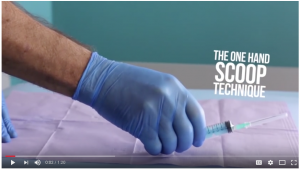Precaution must always be taken when using items such as needles, glass slides and cover slips, glass stir rods, pipettes, capillary tubes, scalpels/blades, or potentially even petri dishes (if these break then they have sharp edges). The most common causes of needle sticks/sharps injuries are re-capping needles, improper disposal of needles, cuts caused by breakage of pipettes/capillary tubes, etc., and cuts caused by handling broken glassware.
All sharps injuries carry the risk of secondary infections in addition to exposure to the item’s content and/or contamination on the outside of the needle or other sharp instrument. Furthermore, needle/syringe usage may present a risk of exposure to infectious agents or other hazardous materials via sprays and aerosols, particularly from non needle-locking syringes.
Sharps Policies; Use Safety-Engineered Sharps- Needles and syringes, or other sharp instruments, should be used only when there is no alternative.
- Plasticware should be substituted for glassware whenever possible.
- Use needleless systems, blunt-ended needles, syringes that re-sheathe the needle, safety scalpels, or other sharps safety devices whenever possible. For example:
- The University of Virginia has a list of vendors for safety-engineered sharps devices, including re-sheathing needles and safety scalpels, available at https://www.medicalcenter.virginia.edu/epinet/new/safetydevice.html
- Mylar-wrapped safety hematocrits are available (Hemato-Clad) from venders such as Fisher
- safeneedle.org
- Procedure-specific handling and disposal of sharps must be included in your lab’s written Standard Operating Procedures.
- Perform an annual review your lab’s need to use sharps. Is it possible to modify a procedure so sharps are not needed?
- Note: The need to re-use and/or re-cap needles, along with the method employed, must be documented in your Standard Operating Procedures. The BMBL does not permit re-capping of needles used in BSL-2 procedures for any reason.
Handling Procedures
- Needles must not be bent, sheared, broken, recapped, removed from disposable syringes, or otherwise manipulated before disposal.
- Do not pick up broken glass with hands. Use mechanical means such as a brush and dustpan, tongs, or forceps.
If You Must Re-Use or Re-Cap a Needle/Syringe
If there is no alternative to re-using a needle/syringe for a specific procedure:
- Avoid re-capping the needle by placing the needle/syringe in a tray or other protective container for transportation or storage between injections.
- If there is no alternative to re-capping the needle:
- First Choice: use a re-sheathing needle, or an automatic re-sheathing needle.
- Second Choice: use a simple and inexpensive mechanical device to safely hold caps while re-capping. Two examples:
- Third Choice: if the above re-sheathing or mechanical re-capping devices do not work for an application, for RG1 Agents only:
Spray and Aerosol Prevention
- Needles & Syringes. Sprays or aerosols may be generated if a needle disengages from a syringe. CDC/NIH guidelines in BMBL states, “Only needle-locking syringes or disposable syringe-needle units (i.e., needle is integral to the syringe) are used for injection or aspiration of infectious material.”
- Use needle-locking syringes for all needle/syringe applications to prevent exposure to sprays and aerosols. This includes injections, filtration, transfer of liquids, and loading columns.
- The use of needle-locking syringes will also prevent the loss of valuable samples. One cc syringes are now available with needle locks or permanently attached needles.
- Follow these guidelines for preventing aerosol production.
Sharps Disposal
- Promptly dispose of all used sharps into the sharps container. Do not re-cap used needles; instead place them directly into the sharps container.
- Place broken glass into the broken glass containers.
- Place the sharps containers within easy reach of work stations where sharps are generated.
- Use a size and shape container that will allow the sharp to freely and completely enter the container.
- Never fill containers more than 3/4 full.
- Bring the full sharps container to RNS 341, or contact a Stockroom Manager or the CHO for container removal.
- If you need a new sharps or broken glass container then contact the Stockroom Manager.

You must be logged in to post a comment.